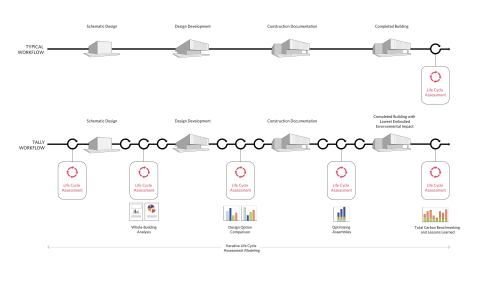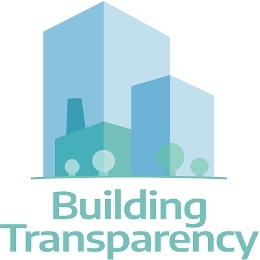SEATTLE--(BUSINESS WIRE)--Tally®, the first Life Cycle Assessment (LCA) app fully integrated into Autodesk® Revit®, which quantifies and analyzes carbon locked in building materials, is scheduled to be transferred from the internationally renowned architecture firm KieranTimberlake to Building Transparency, an organization that provides open-access data and tools in order to reduce embodied carbon emissions and foster a better building future.
Tally was developed by KieranTimberlake, the architecture firm known for its award-winning design and world leadership in practice-based architectural research and sustainable buildings, along with its research development subsidiary KT Innovations. By transferring Tally to Building Transparency, KieranTimberlake makes the app accessible to the entire building and construction industry. With this transfer, both organizations bolster their commitment to reducing the environmental impact of new buildings. Together, they are moving the industry goal posts forward to mitigate the carbon risks in buildings before they are built, rather than after they are constructed.
With building professionals increasingly making carbon assessments part of their ethical and inspired design practices, this powerful plug-in allows them to gauge—in real time—the environmental impacts of their materials choices at pivotal points in the design process. Embodied carbon, a byproduct of building materials, accounts for 11% of annual global emissions. The app is considered a game-changer for those in the high-carbon-output architecture, engineering, and construction industries. It has the power to transform practices at the daily decision-making level, encouraging and producing real, long-term change in the fight against climate abuse.
“Building Transparency is thrilled to add Tally to our portfolio of tools and resources that support a better building future,” says Stacy Smedley, Chair and Executive Director of Building Transparency. “The list of materials and quantities generated in Tally imports directly to the Embodied Carbon in Construction Calculator (EC3) tool, so bringing these assets under one roof fosters a more efficient process workflow to optimize both tools’ capabilities.” The EC3 tool compiles thousands of digitized Environmental Product Declarations (EPD) in a free, open-source database to help estimate the overall embodied carbon emissions based on the materials selected in the design and procurement phases of a project.
“Tally is and will continue to be a tool for project stakeholders to situate their design decisions within the realm of climate action,” says Billie Faircloth, Partner and Research Director of KieranTimberlake. “Tally was launched in 2013 with one ambition: To give designers the means to measure embodied environmental impacts so they can make more responsible choices during the design process.”
Tally’s Benefits for the Building Industry
The versatile Tally app allows users to include comprehensive information about the materials and products their buildings will contain within their Autodesk Revit models and quantify a building’s or material’s embodied carbon impacts to land, air, and water systems. This allows users to conduct whole-building LCAs during design, and use that data to run comparative analyses of various design options that show their differing environmental impacts.
Understanding the impact of building materials and material assemblies traditionally involves modeling. While architects and other building professionals should be able to conduct LCAs using Building Information Modeling (BIM), these models usually do not contain all of the materials that comprise a building. This challenge prompted KieranTimberlake’s affiliate company, KT Innovations, along with partners Autodesk Sustainability Solutions and Sphera (formerly known as Thinkstep), to create Tally.
What Tally offers is a full spectrum of information at great speed and accuracy, as the materials list automatically updates throughout the design phase in real-time. The app generates clear and transparent data graphics, facilitating vital communication regarding design choices between various groups within a project team. This practice ensures that the intent of the Tally LCA is carried through to the completed project, empowering choices to, for instance, to reduce embodied carbon and bringing carbon accountability to the building material supply chain.
“KieranTimberlake created Tally as an act of advocacy,” adds Faircloth. “Our gifting of Tally to Building Transparency is a key next step toward realizing that ultimate goal: To coalesce the architecture, engineering, and construction industries’ efforts to work together on true solutions for a more sustainable future.”
To learn more about Tally, or request a free trial, visit choosetally.com.
About Building Transparency
Building Transparency is a 501(c)3 nonprofit organization that provides open access data and tools that support broad and swift action across the building industry in addressing embodied carbon’s role in climate change. Formed in 2020, Building Transparency hosts, manages and maintains the Embodied Carbon in Construction Calculator (EC3) tool, which provides thousands of digitized EPDs in a free, open-source database. Building Transparency strives to provide the resources and education necessary to promote adoption of the EC3 tool, including through the official materialsCAN program, and works with global policymakers to shape a better building future.
Learn more about Building Transparency at www.buildingtransparency.org.
About KieranTimberlake
KieranTimberlake is an award-winning architecture and research practice based in Philadelphia, Pennsylvania and is internationally known for design leadership and technical innovation. Founded in 1984, KieranTimberlake is committed to creating positive change in the built environment through beauty and performance, designing buildings that are holistically integrated with their context. KT Innovations, the developer of Tally, is an affiliate of KieranTimberlake.
Visit kierantimberlake.com for more information.






